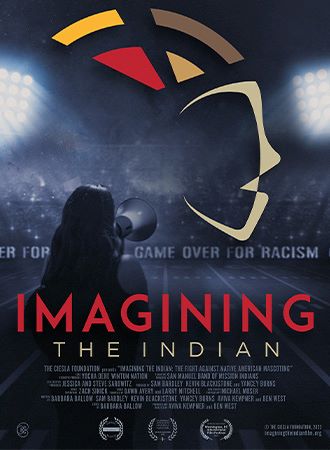
Imagining the Indian: The Fight Against Native American Mascoting 2022
Distributed by Collective Eye Films, 1315 SE 20th Ave. #3, Portland OR 97214; 971-236-2056
Produced by Ciesla Foundation
Directed by Ben West and Aviva Kempner
Streaming, 95 mins
College - General Adult
Native Americans; Protest Movements
Date Entered: 05/03/2023
Reviewed by Laura Harris, Web Services & Distance Learning Librarian, SUNY OswegoImagining the Indian focuses on Native Americans’ ongoing struggle to eliminate the use of racist slurs and caricatures in sports.
The film's narrative is nonlinear, with themes appearing and reappearing throughout. One overarching theme is the representation and depiction of Native Americans. European depictions of Native Americans have dominated for hundreds of years, across a wide variety of media – from portraiture to cartoons to film. These depictions paint Native Americans as stupid, evil, overly sexual, animalistic, violent, and less than human.
This discussion helps the viewer to understand the pervasiveness of these misrepresentations, which in turn explains how these misrepresentations were carried into sports. Actress and member of the Cherokee Nation, DeLanna Studi, and Stephanie Fryberg, professor of psychology and member of the Tulalip Tribes, both call attention to the fact that many mascots are animals. Kevin Gover, Under Secretary for Museums and Culture at the Smithsonian and member of the Pawnee Nation of Oklahoma, notes that many mascots were also chosen for their ability to do violence. These depictions serve to reinforce the idea of Native Americans as “other.”
It's not surprising that these representations are harmful to Native Americans. The film mentions a few research studies that show the deleterious effects on Native Americans, and several anecdotes are also shared. In mainstream American schools, students are typically taught that events such as the California Gold Rush and the 1889 Oklahoma Land Run were positive events. Several Native Americans shared the cognitive dissonance they felt at being asked to celebrate events that led to the displacement and murder of their people.
Some specific examples of team mascots are discussed, primarily those in well-known sports leagues such as the National Football League, Major League Baseball, and the National Basketball Association. While specific teams are discussed at length – such as the Washington Commanders (previously Redskins) – the viewer has the sense that activists have received considerable pushback from the NFL. For instance, the NFL prevented activists from airing a commercial about the Change the Mascot campaign during the Super Bowl. In contrast, the NBA consented to air the same ad during finals. The film also discusses the prominence of Native American-themed mascots at high schools, colleges, and universities.
The work done to combat the use of these mascots is also discussed at length. Suzan Shown Harjo and Amanda Blackhorse are two notable activists highlighted in the film, specifically, their work in legal battles involving team trademarks. More current activist work has focused on other means of activism, such as increasing public awareness and corporate responsibility. It is noted that while Harjo and Blackhorse’s work was instrumental in the Washington Commanders’ new name, pressure from one of the team’s sponsors may have ultimately led the team’s owners to change their name. Also notable is the work of Joely Proudfit, whose work with her students entailed mapping out high schools in California with Native American mascots. This work helped lead to the first anti-Redskins bill passed in the United States.
The film closes with a discussion of the new generation of activists, including non-Native persons, and a sense of hope that this activist work will continue.
The voices of many Native Americans are included in the documentary, and their inclusion helps to dispel the myth that Native Americans are monolithic.
Overall, the film provides a compelling argument about why Native American mascoting prevents Native Americans being seen for themselves, and how it serves as a barrier to authentic Native American representations in the media. Because the nonlinear narrative style may be unfamiliar to some viewers, this film is recommended for college-level learners and other adults.
Awards:2022 SOO Film Festival, Audience Choice Award for Documentary Film; 2022 Boston International Film Festival, Best Documentary; 2022 Lavine/Ken Bruns Prize, Finalist
Published and licensed under the Creative Commons Attribution 4.0 license. Anyone can use these reviews, so long as they comply with the terms of the license.